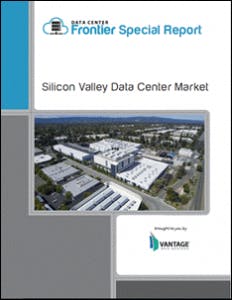Vantage Opens Newest Data Center in Supply-Constrained Santa Clara
Vantage Data Centers has completed construction of its final data center at its Santa Clara campus, bringing 15 megawatts of capacity online in a supply-constrained Silicon Valley market. The four-story V5 data center completes the company’s Santa Clara campus, which now hosts 75 megawatts of data center capacity for some of the world’s leading technology companies.
“Silicon Valley continues to be a vital and strategic market for our customers,” said Vantage President and Chief Executive Officer Sureel Choksi. “With the final facility on our first Santa Clara campus complete, and construction of our 69 megawatt Matthew Street campus also in Santa Clara well underway, Vantage can support the growth of enterprises, cloud and hyperscale customers well into the future.”
The new V5 building features a cooling system employing a combination of outside air and a chilled water loop, which uses recycled water and modular chiller and dry-cooler technology designed to minimize water usage while maintaining ultra-low energy efficiency and PUE (Power Usage Effectiveness, a leading efficiency metric)s. The water loop also utilizes non-potable grey water, further reducing impact on local water resources.
The Vantage V5 data center during its final stages of construction. (Photo: Rich Miller)
“We’re particularly proud of the gains in performance and cooling we’ve made with this new expansion,” said Chris Yetman, Vantage’s Chief Operating Officer. “Vantage’s continued dedication to providing sustainable value, optimized for the wholesale environment, is one of the reasons we’ve had such success in Silicon Valley.”
New Supply in a Tight Market
Silicon Valley is one of the largest and most important data center markets in the U.S., providing space for servers to deploy new hardware and services from the Valley’s marquee technology companies, as well as a legion of fast-moving startups. The region is facing a shortage of finished data center space due to a dwindling supply of development sites in key data center corridors.
This places a premium on new projects in Santa Clara, the region’s primary data center hub, due to its lower cost of electric power. That’s why new inventory has been quickly gobbled up by tenants, who often have pre-leased space.
Vantage has leased 90 percent of the 9 megawatts of available space at its V6 facility in Santa Clara, which opened its doors in October. The company has signed three different deals to take up most of the space in the new building. Meanwhile, Digital Realty has reportedly leased the entire 6 megawatts of capacity it has brought online at its new data center on Alfred Street in Santa Clara.
Santa Clara has long been the Data Center Capital of Silicon Valley due to competitive power pricing from the municipal utility, Silicon Valley Power. That’s why there’s 35 data centers are located in an 18-square mile municipality.
Download the full report.
The current shortage of wholesale data center space resulted from a surge in leasing in 2015 and early 2016, when there were nine leases in Santa Clara that exceeded 2 megawatts, totaling more than 40 megawatts of deals, according to data from North American Data Centers. Between April 2016 and the end of 2017, there were just three new wholesale leases announced of 2 MWs or more in Santa Clara, They are also building totaling about 7.5 MWs of space.
New Strategies to Add Capacity
Data center developers are pursuing several strategies to bring new sites online and maximize their capacity. With few greenfield development sites, developers are buying existing office buildings, and either retrofitting them or knocking them down to make way for data centers.
Office buildings are more expensive than vacant land. As an example, in June Digital Realty paid about $4.3 million per acre for its new expansion property, which housed several office buildings. That’s about three times the per-acre price for recent deals in Ashburn, Virginia.
They are also building taller sites to get the most capacity possible out of their existing real estate. Both CoreSite SV7 and Vantage V5 are four-story data centers
Vantage is pursuing both strategies in its expansion campus on a 9-acre site on Mathew Street in Santa Clara, where Vantage has broken ground on a major new cloud campus, which will be home to four data centers offering 69 megawatts of critical IT load. The site is adjacent to large data centers operated by Digital Realty Trust and DuPont Fabros.
Next year Digital Realty will knock down two existing buildings on Lafayette Street in Santa Clara to make way for 403,000 square feet of new data center space. The new project will provide Digital Realty with 48 megawatts of capacity in Santa Clara.
Meanwhile, CoreSite has space remaining in its SV7 facility in Santa Clara, and has begun work on a new data center on adjacent property that could support as much as 18 MWs of capacity when it is completed, most likely in 2019.
Vantage recently announced plans to invest $1 billion in a new campus in Ashburn, which is the largest and busiest data center market in the world. Vantage plans to build 108 megawatts of data centers on a 42-acre property, making it one of four new players in the Northern Virginia market this year.
In February, Vantage lined up more than $1.1 billion in financing to build new data centers as it continues its national expansion. The money was raised using securitization financing, an approach that allows Vantage to pay lower interest rates on its debt, which reduces its costs as it seeks to compete in the industry’s largest markets.
About the Author




